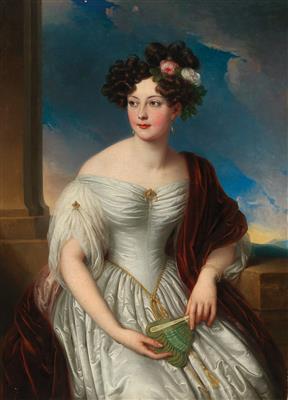Johann Nepomuk Ender

(Vienna 1793–1854)
Portrait of Pauline of Württemberg (1800–1873) before a landscape background, signed, dated Ender Johann 1831, oil on canvas, 117 x 86 cm, framed, (Rei)
Provenance:
Sotheby’s London, 21 June 1993, lot 17;
Private Collection, Germany.
The twin brothers Thomas and Johann Nepomuk Ender were both considered esteemed painters during their lifetime already. Whilst Thomas turned to landscape painting and was able to undertake numerous research expeditions with the support of Prince Clemens von Metternich, Johann Nepomuk devoted himself to history painting and the depiction of genre scenes. Johann Nepomuk studied at the Academy of Vienna under Heinrich Füger and Johann Baptist Lampi the Elder. His predilection for historical and genre paintings was shaped considerably by those years. Like his brother, Johann Nepomuk undertook numerous research trips, which took him to Greece and Italy, amongst other places. He travelled to these countries with Count Stephen Széchényi on expeditions that resulted in numerous sketches and studies, which subsequently served as the groundwork for his paintings. On his return from his journeys, Johann Nepomuk wished to devote himself first to historical pictures, but received commissions for portraits of the ruling family. In these often half-length portraits, he treats materials, above all, with great care. A considerable role is attributed to decorations, uniforms and to the ladies’ opulent clothes.
The lady depicted here is Pauline von Württemberg. Just as in the portraits of high society so typical of Ender, in this portrait of a lady, too, he represents the fashionable novelties of his time as well as the most fashionable women’s haircuts. His female protagonists are mostly rendered in an elegant pose, often with an accessory in hand. In the present painting, Ender emphasises the delicate gracefulness of the woman portrayed. The soft chiffon material drapes itself over her shoulders; in her hand she holds a fan; flowers can be seen in her hair. Her gaze to the side seems dreamy. Behind her, the view opens up to the observer into a landscape which cannot be identified. This style of representation found considerable acclaim in aristocratic circles, which explains the large number of these portraits.
As a philanthropist for the underprivileged, Pauline von Württemberg enjoyed great popularity, as shown by the numerous streets and squares named after her.
Specialist: Mag. Dimitra Reimüller
 Mag. Dimitra Reimüller
Mag. Dimitra Reimüller
+43-1-515 60-355
19c.paintings@dorotheum.at
27.04.2017 - 18:00
- Realized price: **
-
EUR 15,000.-
- Estimate:
-
EUR 12,000.- to EUR 18,000.-
Johann Nepomuk Ender
(Vienna 1793–1854)
Portrait of Pauline of Württemberg (1800–1873) before a landscape background, signed, dated Ender Johann 1831, oil on canvas, 117 x 86 cm, framed, (Rei)
Provenance:
Sotheby’s London, 21 June 1993, lot 17;
Private Collection, Germany.
The twin brothers Thomas and Johann Nepomuk Ender were both considered esteemed painters during their lifetime already. Whilst Thomas turned to landscape painting and was able to undertake numerous research expeditions with the support of Prince Clemens von Metternich, Johann Nepomuk devoted himself to history painting and the depiction of genre scenes. Johann Nepomuk studied at the Academy of Vienna under Heinrich Füger and Johann Baptist Lampi the Elder. His predilection for historical and genre paintings was shaped considerably by those years. Like his brother, Johann Nepomuk undertook numerous research trips, which took him to Greece and Italy, amongst other places. He travelled to these countries with Count Stephen Széchényi on expeditions that resulted in numerous sketches and studies, which subsequently served as the groundwork for his paintings. On his return from his journeys, Johann Nepomuk wished to devote himself first to historical pictures, but received commissions for portraits of the ruling family. In these often half-length portraits, he treats materials, above all, with great care. A considerable role is attributed to decorations, uniforms and to the ladies’ opulent clothes.
The lady depicted here is Pauline von Württemberg. Just as in the portraits of high society so typical of Ender, in this portrait of a lady, too, he represents the fashionable novelties of his time as well as the most fashionable women’s haircuts. His female protagonists are mostly rendered in an elegant pose, often with an accessory in hand. In the present painting, Ender emphasises the delicate gracefulness of the woman portrayed. The soft chiffon material drapes itself over her shoulders; in her hand she holds a fan; flowers can be seen in her hair. Her gaze to the side seems dreamy. Behind her, the view opens up to the observer into a landscape which cannot be identified. This style of representation found considerable acclaim in aristocratic circles, which explains the large number of these portraits.
As a philanthropist for the underprivileged, Pauline von Württemberg enjoyed great popularity, as shown by the numerous streets and squares named after her.
Specialist: Mag. Dimitra Reimüller
 Mag. Dimitra Reimüller
Mag. Dimitra Reimüller
+43-1-515 60-355
19c.paintings@dorotheum.at
|
Buyers hotline
Mon.-Fri.: 10.00am - 5.00pm
kundendienst@dorotheum.at +43 1 515 60 200 |
| Auction: | 19th Century Paintings |
| Auction type: | Saleroom auction |
| Date: | 27.04.2017 - 18:00 |
| Location: | Vienna | Palais Dorotheum |
| Exhibition: | 15.04. - 27.04.2017 |
** Purchase price incl. charges and taxes
It is not possible to turn in online buying orders anymore. The auction is in preparation or has been executed already.
